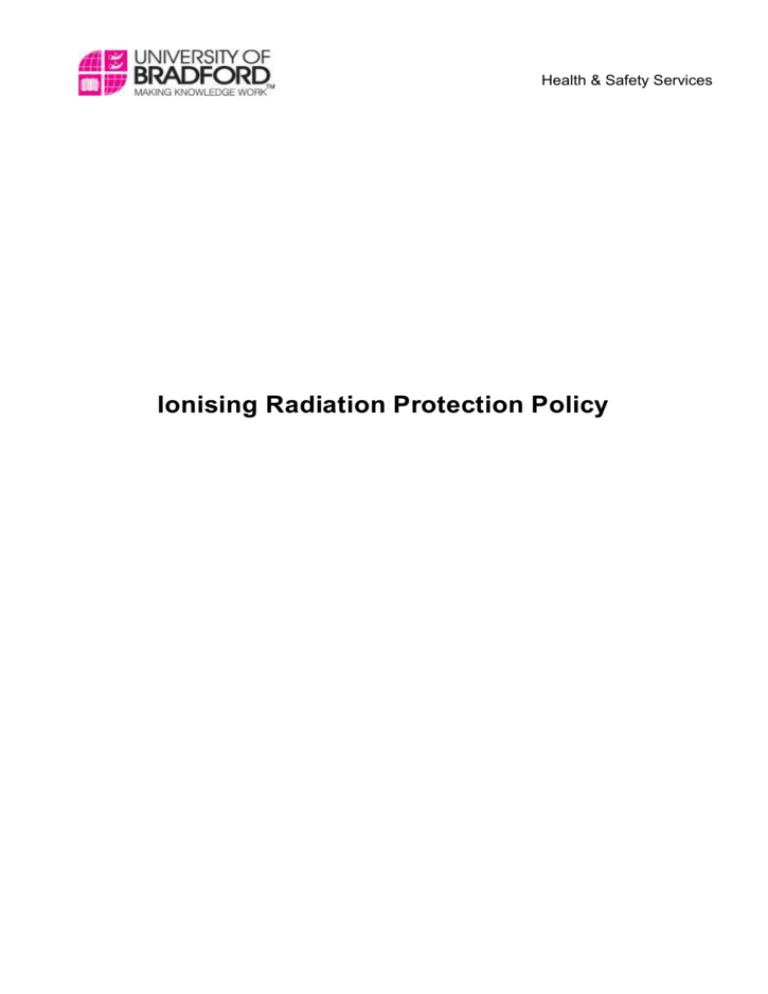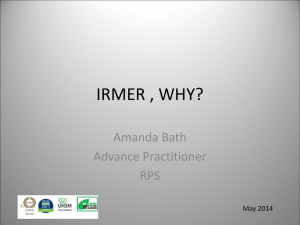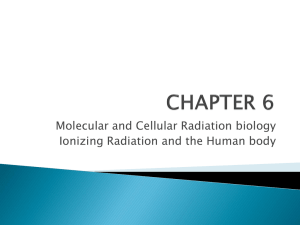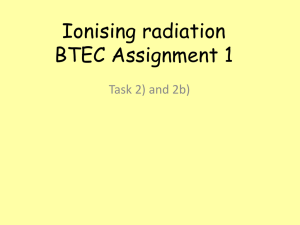Ionising Radiation Protection Policy
advertisement

Health & Safety Services Ionising Radiation Protection Policy Table of Contents 1. Purpose ................................................................................................................................ 2 2. Scope and Objectives ........................................................................................................... 2 3. Definitions ............................................................................................................................. 2 4. Principles .............................................................................................................................. 3 5. 4.1 Basic Safety Principles ................................................................................................... 3 4.2 Classified Workers .......................................................................................................... 3 4.3 Performance Standards and Auditing ............................................................................. 3 Responsibilities ..................................................................................................................... 4 5.1 Vice Chancellor ............................................................................................................... 4 5.2 Radiation Protection Sub- Committee ............................................................................. 4 5.3 Radiation Protection Adviser / Medical Physics Expert / Radioactive Waste Adviser ..... 5 5.4 Schools ........................................................................................................................... 5 5.4.1 Deans of Schools ......................................................................................................... 5 5.4.2 Heads of Departments ............................................................................................. 5 5.4.3 Radiation Protection Supervisors ............................................................................. 6 5.5 Responsibilities of All Staff & Students ........................................................................... 6 5.6 Outside Workers ............................................................................................................. 6 6 References ........................................................................................................................... 6 8. Policy Review ....................................................................................................................... 7 9. Ratification ............................................................................................................................ 7 Appendix A................................................................................................................................... 8 Basic Safety Principles ............................................................................................................. 8 Appendix B................................................................................................................................. 10 Duties of a Radiation Protection Supervisor ........................................................................... 10 1 1. Purpose This Policy is intended to confirm those management arrangements that have been made for the identification, assessment and subsequent removal or reduction of risks to staff, students and visitors arising from the use of ionising radiation on behalf of the University. 2. Scope and Objectives The Policy outlines and describes the University's uses of ionising radiation and the major pieces of legislation which pertain to those uses. The various organisational arrangements necessary to implement and ensure compliance with the legislation are also described, including the major aspects of documentation and necessary record keeping. The Policy describes the main basic safety principles that must be followed when ionising radiations are used. The Policy accepts that advice and accepted standards in practice and radiation protection from various professional bodies are under constant review and development. Therefore, the Policy formalises the management of this advice and adopted standards rather than defining in detail the standards themselves. The Policy contains a number of appendices, outlining the current staff with specific responsibilities in respect of the Policy and outlines those sections of particular relevance to the key personnel and other staff groups. The University recognises that safe systems of work are dependent on those users of ionising radiation and the facilities, equipment, training and competence of these staff, as well as the procedures developed to minimise the risk of harm due to improper use of ionising radiation 3. Definitions Controlled Area is an area used for work with ionising radiation where significant radiation doses are possible and where special controls and working practices are required. Ionising Radiation is the transfer of energy in the form of particles or electromagnetic waves of wavelength 100nm capable of producing ions directly or indirectly. Local Rules are a basic safety system and systems of work drawn up by the local Radiation Protection Supervisor for use in Controlled and Supervised Radiation Areas. Outside Workers are classified radiation workers not employed by the University. Supervised Area is an area used for work with ionising radiation where radiation doses above the public dose limit are possible and where supervision is required to monitor those doses. 2 4. Principles 4.1 Basic Safety Principles Staff and students working with ionising radiation will follow the basic safety principles laid out in Appendix A of this Policy. 4.2 Classified Workers The University will endeavour to ensure that exposures to individuals shall not result in individuals having to be classified radiation workers under the terms of the Ionising Radiation Regulations 1999 The Radiation Protection Adviser will advise the University if any individual person and/or work activity shall arise that requires individuals to be so classified. Such classified persons shall comply with the requirements placed on them for personal radiation dose monitoring from an Approved Dosimetry Service to establish their exposure and review such working practices so as to investigate whether their working practices can be modified to limit their exposure so far as reasonably practicable. Employees designated as classified radiation workers on the advice of the Radiation Protection Adviser should receive medical supervision through the University's Occupational Health Department to the Health and Safety Executive’s Employment Medical Adviser. It should be noted that there are currently no classified radiation workers within the University. 4.3 Performance Standards and Auditing Compliance with the legislation is monitored by: Regular inspection and internal audit by Managers under the auspices of the Radiation Protection Adviser/Medical Physics Expert/Radiation Waste Advisor; and External audit by the appropriate administrative bodies such as Environment Agency, Health and Safety Executive, Care Quality Commission and the Medicines Control Agency. Key audit items will include checking compliance with: The University’s written procedures made under Ionising Radiation Regulations 1999 and Ionising Regulations (Medical Exposure )Regulations 2000 (as amended 2006 & 2011); Results of quality assurance programmes; The provisions of the terms of the Holding Limits, Authorisation or Permits made under Environmental Permitting Regulations 2010 (as amended 2011); Keeping of written records required by the different Regulations; Dose optimisation. 3 Compliance will be co-ordinated by the Radiation Protection Adviser/Radiation Waste Adviser for those issues pertaining to the uses of ionising radiation by the University. An annual report will be made by the Radiation Protection Adviser/Radiation Waste Adviser to the University, highlighting all the above key indicators. 5. Responsibilities 5.1 Vice Chancellor The Vice Chancellor has overall statutory and operational responsibility for managing issues arising from the uses of ionising radiation in the University. There is a responsibility to ensure that a Radiation Protection Adviser is duly appointed to advise the University on all matters pertaining to the uses of ionising radiation. That appointment must be made of a suitable person or ‘Radiation Protection Adviser body’, certified by an appropriate body [recognised by the Health and Safety Executive] to act as a Radiation Protection Adviser. 5.2 Radiation Protection Sub- Committee The University runs a Radiation Protection Sub-Committee, consisting of a senior member of the Academic Staff with specialist knowledge in the field of ionising radiation, together with the University Radiation Safety Officer, the Radiation Protection Adviser and the Head of Health & Safety Services. Its terms of reference are to: Advise the Health & Safety Committee on matters concerning Radiological Protection; Evaluate, recommend and periodically review training for all users of ionising and nonionising radiation; Identify, implement, monitor and review policies and procedures required by Ionising Radiation Regulations 1999, Ionising Regulations (Medical Exposure) Regulations 2000 (as amended 2006 & 2011); and Environmental Permitting Regulations 2010 (as amended 2011); Advise on procedural aspects of experimental work involving ionising and non-ionising radiation; Approve registration applications for work with ionising and non-ionising radiation; Periodically audit the University’s radiation facilities; Meet at appropriate intervals; 4 5.3 Radiation Protection Adviser / Medical Physics Expert / Radioactive Waste Adviser The duties of the Radiation Protection Adviser/Medical Physics Expert/Radiation Waste Advisor include monitoring the use of ionising radiation within the University, and advising the University on all matters of safety regarding the use of ionising radiation. The Radiation Protection Adviser/Medical Physics Expert/Radiation Waste Advisor will report any breaches of the appropriate legislation through Health & Safety Services to the most senior responsible University manager available, so that management is briefed, in particular prior to reporting any non-compliance(s) with the appropriate government executive or agency if required under legislation. Advice on radiation protection issues is available to all staff on request, although risk assessments, reports and formal contact are usually arranged through Health & Safety Services. 5.4 Schools 5.4.1 Deans of Schools The School management integrates the management of work with ionising radiation into its operational and business processes. They bear overall responsibility for the implementation and monitoring of the principles established by this Policy. This is achieved by the enforcement of appropriate management practices and procedures and the provision of adequate resource. The Head of Health and Safety Services and Radiation Protection Adviser/Medical Physics Expert/Radiation Waste Advisor will advise the School on its role. The School will ensure that joint ventures maintain an adequate level of safety management as defined in this Policy. 5.4.2 Heads of Departments The Head of Department is responsible for the implementation of this guideline within designated laboratories following consultation with the School management. The Head of Department has an overall responsibility for the establishment of an appropriate, effective and efficient management system. This includes, but is not limited to the following aspects: Appropriate risk assessments are made, training is given and relevant safety information made available to individuals working with ionising radiation. Records of this assessment, training and information are made available to the employee and Radiation Protection Adviser/Medical Physics Expert/Radiation Waste Advisor; Under the terms of Ionising Radiation Regulations 1999 and its Approved Code of Practice, they appoint sufficient numbers of suitably-qualified and trained personnel to act as Radiation Protection Supervisor’s in all work areas designated for use with ionising radiations; No employee or trainee under the age of 18 years under their supervision shall be exposed to ionising radiation in the course of their work activity, as required under Ionising Radiation Regulations 1999; They draw up and maintain written procedures required under Ionising Radiation 5 Regulations 1999, Ionising Radiation (Medical Exposure) Regulations 2000 (as amended 2006 & 2011) and Environmental Permitting Regulations 2010 (as amended 2011); Contingency plans exist so that any failure of systems and/or equipment resulting in an incident involving ionising radiation is adequately dealt with in a timely manner and that the Radiation Protection Adviser/Medical Physics Expert/Radiation Waste Advisor is notified as soon as practicable; They maintain a programme of internal audit of compliance with Local Rules and procedures; 5.4.3 Radiation Protection Supervisors 5.5 Perform the duties outlined in Appendix B of this Policy. Responsibilities of All Staff & Students All members of staff & students have a duty to protect themselves, their colleagues and others from all hazards arising from their work. For this reason those working with ionising radiation must become familiar with and observe the Local Rules for that area. Anyone unfamiliar with work using ionising radiation must follow the direction of persons responsible for that area or task and comply with their direction under the systems of work laid out in the Local Rules for that area. Reporting of any incidents or non-compliance with Local Rules must be made in accordance with those Local Rules and through the University’s Risk Incident Reporting Procedure. 5.6 Outside Workers Outside Workers must report to the local Radiation Protection Supervisor prior to starting work in any Controlled Areas within the University and at the end of their work for an appropriate dose assessment to be entered into their dose record. 6 References Management of Health & Safety at Work Regulations 1999; Ionising Radiation Regulations 1999; Ionising Radiation (Medical Exposure) Regulations 2000 (as amended 2006 & 2011); Environmental Permitting Regulations 2010 (as amended 2011); Carriage of Dangerous Goods and Use of Transportable Pressure Equipment Regulations 2009; Approved Code of Practice – Work with Ionising Radiation; and 6 Association of University’s Radiation Protection Officers - Guidance on Working with Ionising Radiations in Research and Teaching 8. Policy Review This policy will be reviewed every two years. 9. Ratification This Policy was developed by Health and Safety Services and Your RPA and approved by the Health and Safety Committee on 28 January 2013. 7 Appendix A Basic Safety Principles A1 Staff or students working with ionising radiations must ensure that all necessary steps are taken to minimise, so far as is reasonably practicable, exposure of staff, students and members of the public to ionising radiations used within the University. A2 All equipment that delivers or controls the production of ionising radiations within the University must be constructed, installed and maintained such that it minimises untoward radiation exposure, consistent with its medical uses. The installation process must include a critical examination of the equipment, a regular maintenance programme and tests of performance and safety at regular intervals (Quality Assurance) with written records of the results kept for audit and review under the terms of Ionising Radiation Regulations 1999 and Ionising Radiation (Medical Exposure) Regulations. A3 All staff and students must undergo sufficient instruction and training prior to work with ionising radiations such that they are able to perform their duties safely with respect to themselves, other staff, students and members of the public. This is based on attendance at the University’s Radiation Protection course or some other appropriately certificated course, to demonstrate that training has taken place to an appropriate level for the task to be undertaken safely. A4 Radioactive substances must only be used in accordance with the holding limits, authorisations and/or permits issued under the terms of Environmental Permitting Regulations. A4.1 The accumulation and disposal of radioactive waste must only be made under the terms specified in the holding limits, authorisations and/or permits granted under Environmental Permitting Regulations. A4.2 The responsibility for ensuring this is done rests with the appropriate Radiation Protection Supervisors. A5 Departmental procedures must be followed to ensure that staff, students or visitors who are, or may be, pregnant are not unwittingly exposed to ionising radiations. A6 Staff or students working with ionising radiation who become pregnant have a duty to inform the University in writing as soon as practicable so that a suitable risk assessment and, if applicable, work programmes are arranged for the remaining duration of their pregnancy. The dose to the foetus should not exceed 1mSv for the declared remainder of the pregnancy. A7 Any suspected unintentional exposure of staff, students or visitors to ionising radiations must be reported to the appropriate Radiation Protection Supervisor at the earliest 8 possible opportunity, who will conduct an investigation taking advice from the Radiation Protection Adviser/Medical Physics Expert/Radiation Waste Advisor where necessary. The results of that investigation must be reported to the appropriate Manager and through the University Incident Reporting Procedure. External agencies such as the Care Quality Commission, Health and Safety Executive, or Environment Agency will be notified in accordance with statutory obligations. 9 Appendix B Duties of a Radiation Protection Supervisor The following duties apply in respect of all uses of ionising radiation in the University. The Radiation Protection Supervisor shall; 1. Ensure compliance with Ionising Radiation Regulations 1999, Ionising Radiation (Medical Exposure) Regulations 2000 (as amended 2006 & 2011), where appropriate and Environmental Permitting Regulations; 2. In consultation with the Radiation Protection Adviser, draw up Local Rules under Ionising Radiation Regulations 1999 and the provisions of Approved Code of Practice for use in each radiation work area, describing the arrangements in the University for meeting the requirements of the regulations. The Rules must contain sufficient detail to comply with the requirements of the Approved Code of Practice to Ionising Radiation Regulations 1999. Copies of Local Rules must be displayed in each radiation work area, and central copies held by the Radiation Protection Supervisor and Radiation Protection Adviser/Medical Physics Expert/Radiation Waste Advisor 3. All Local Rules should be reviewed by the Radiation Protection Supervisor in the light of any major changes to working practices within the area, or at least every two years whichever is the sooner. 4. Ensure all staff, students and visitors are adequately instructed about radiation hazards and precautions they need to observe (particularly the appropriate use of protective clothing and/or protective screens). 5. Arrange that each member of staff working in Controlled or Supervised Radiation Areas is familiar with the Local Rules and signs a statement that he or she has read them and agrees to act in accordance with them; 6. Organise and administer the assessment of doses to staff by means of personal dose monitors, including preparation and review of a list of staff to be monitored in consultation with Health & Safety Services and retention of dose assessment records in the x-ray department for two years. 7. Report immediately to the Head of Department on unsatisfactory conditions of radiation safety and to propose measures to remedy them and to confirm that agreed remedies have been effected; 8. Ensure that Health & Safety Services are consulted when it is proposed to alter the operating conditions of an x-ray installations whether by new or modified buildings or equipment, or by change of procedures or workload; 9. Report directly to Health & Safety Services when necessary in the interest of safety; 10 10. Ensure that excessive exposures of staff or patients as defined in Local Rules are reported to the University via the University’s Risk Incident Reporting Systems; 11. Arrange that checks on the maintenance of x-ray equipment safety features, specified in Local Rules, are carried out and recorded in a log book for each x-ray installation, with special attention to any maintenance or modification which might affect output or quality of the radiation; 12. Arrange that personal protective equipment is examined as specified in Local Rules and that a record of condition is kept for each item. 13. Receive appropriate training and attend updates regarding their statutory duties when acting as Radiation Protection Supervisor as and when deemed appropriate by their Manager and Health & Safety Services. 11








